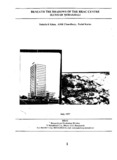Beneath the shadows of the BRAC Centre slums of Mohakhali
Citation
Khan, S. H., Chowdhury, A., & Karim, F. (1997, July). Beneath the shadows of the BRAC Centre slums of Mohakhali. Research Reports (1997): Social Studies, Vol – XV, 1–41.Abstract
This exploratory slum study looked at the demographic, socio-economic, health related, educational,
and political characteristics of the slum dwellers living around the BRAC Centre. The study was
conducted from April to June 199.7. Data was collected primarily by the lead researcher with an open
ended semi-structured questionnaire, and information was collected from the key informants living in
the slums. The slums could be distinguished by their size.
The smaller slums were used by the inhabitants to eat, sleep and reside in, but the larger ones had
shops, bazaars, schools, madrasas, mosques, playgrounds, and even graveyards. The physical
structure of the huts was worse in the smaller than in the larger slums. For example, huts in the
smaller slums were made of chatai, sack, and plastic sheets. In the larger slums the huts were made
of tin roofs and bamboo walls. All huts had earthen floors irrespective of their size. In general the
socio-economic conditions of the smaller slum dwellers were worse than of the larger slum dwellers.
Although located within municipal limits, the slums had limited access to important urban services,
such as, water, electricity and gas, but some slum dwellers managed to get supply/tap water from
various sources and some illegal electricity. The environmental conditions of the slums were very poor
due to high population density, poor housing and pollution of the area by human and factory wastes.
Most slums were established outside the legal framework of the city management. The possibility of
eviction of slum dwellers by land owners was quite high but the slum dwellers were not overtly anxious
over the issue.

